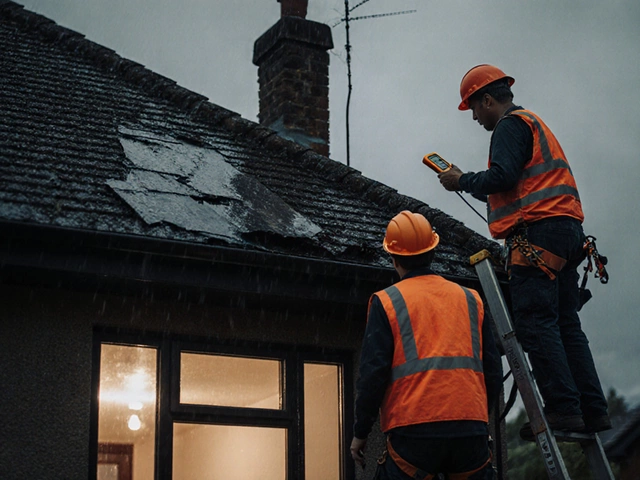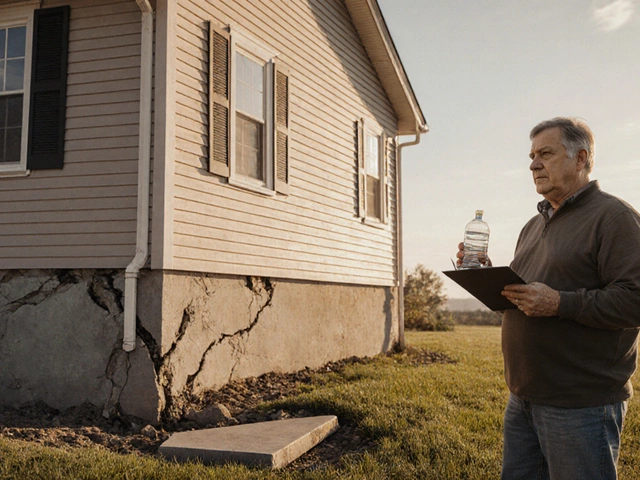You see a hairline crack running across your living room wall, and your first thought is, "Is my house sinking?" Don’t panic yet. Not all cracks or creaks mean your home’s about to fall apart, but some signs definitely shouldn’t be ignored.
If you’re spotting cracks above doors or windows, or your floors suddenly feel less like a hardwood runway and more like a bumpy dirt road, your foundation might be telling you something. Uneven floors, doors that don’t shut right, and gaps forming where walls meet ceilings are classic red flags.
It’s tempting to brush off these little things as nothing. But a fresh crack after a heavy rain, or doors that used to work fine suddenly sticking? That’s your house waving a red flag. Knowing what to look for could save you thousands down the line—and a ton of stress.
- The Most Obvious Signs Something’s Wrong
- Less-Known Clues Hiding in Plain Sight
- Why Do Foundation Problems Even Happen?
- When Should You Worry (And Call for Help)?
The Most Obvious Signs Something’s Wrong
There are a few things that almost scream “foundation issues” the moment you see them. If you know what to look for, you might spot problems before they turn into expensive repairs.
The most common red flags pop up right in front of you—sometimes literally on your walls or floors. Here are the biggest warning signs:
- Cracks in Walls or Ceilings: Not every hairline crack means trouble, but pay attention to ones that are wider than a quarter inch, or cracks that seem to zigzag, go up from doors, or run along the ceiling. Stair-step cracks in brickwork outside are also a problem sign.
- Doors and Windows that Stick or Won’t Close: Did your bathroom door work last month but now it takes muscle to pull shut? If your windows or doors suddenly start sticking, dragging, or won’t close right, it can mean your foundation has shifted.
- Uneven or Sloping Floors: Put a ball on the floor. If it rolls away without any help, your floors aren’t just “settling”—they’re slanting. Uneven floors often mean something serious is happening under your home.
- Gaps Between Walls and Ceiling or Floor: If you spot gaps where the walls meet ceilings or floors, that’s not normal. Your foundation might be sinking or shifting.
- Cracks in the Foundation Itself: Take a look outside at the visible part of your foundation. Wide, jagged cracks or new cracks that seem to grow are a sure sign something’s off.
These warning signs usually don’t show up all at once. But even one or two can mean you’ve got a foundation issue on your hands. If you spot any of these, it’s best not to ignore them—it rarely gets better on its own.
Less-Known Clues Hiding in Plain Sight
Everyone catches big wall cracks, but smaller, sneakier signs of foundation issues often go unnoticed. Ever notice a window that just won’t budge, even after you’ve used a little muscle? Stuck or misaligned windows can point to subtle shifts in your home’s structure. And if your kitchen cabinets or countertops suddenly pull away from the wall, that’s not normal settling—it might mean your foundation isn’t level anymore.
Take a walk through your basement if you have one. You might spot a faint white streak on your walls, almost like chalk dust. That’s called efflorescence, and it means water is finding a way through tiny foundation cracks. Constant moisture against concrete is one of the fastest ways to turn a small problem into a big repair bill.
Don’t forget to look outside. Step back and scan your home. If you notice that your brickwork or exterior siding looks bowed or gaps are forming near the bottom, pay attention. Sometimes even the landscaping tells a story—if your patio or porch is tilting away from the house, the ground underneath could be shifting along with your foundation.
Look for gaps beneath baseboards or between the floor and walls. Is there a random slope in one room, but not the others? Place a ball on the floor. If it rolls away without a push, that’s a bad sign. And don’t ignore odd noises, like popping or creaking you never noticed before. Those could be new, and might hint at shifting beneath your feet.
These little signals are easy to brush off, but catching them early gives you a head start. List your findings, take pictures, and track changes over time. That way, if things get worse, you have real proof to show a pro—and you might actually catch foundation problems before they snowball.

Why Do Foundation Problems Even Happen?
It’s wild how much havoc the ground under your house can cause. Most foundation issues are a result of soil movement, moisture changes, or poor construction from the start. Soil isn’t just some boring dirt—it swells when it gets wet and shrinks when it dries out. If your house sits on “expansive” clay soil, it’s especially risky. In fact, about 60% of U.S. homes are built on soils that move around a lot when it rains or dries, which sets the stage for cracks and sinking.
Sometimes, the problem goes back to poor construction. Maybe the contractor skimped on concrete or missed out on proper footings. Or your house was built on fill dirt that was never compacted right. Simple shortcuts like this become big headaches later.
Another big cause is drainage. Water pooling near your foundation—thanks to clogged gutters, broken downspouts, or bad grading—soaks the soil, which pushes and shoves your foundation. On the flip side, droughts can dry out the soil so much that your foundation drops as the ground shrivels up underneath.
If you’re curious about the main factors at play, here’s a quick breakdown:
- Soil type: Clay soils are notorious for causing foundation movement. Sandy or rocky soils, not so much.
- Moisture swings: Heavy rain, droughts, and plumbing leaks can all mess with your foundation.
- Poor drainage: Letting water hang out near your house is a recipe for disaster.
- Tree roots: Big trees close to your home suck up moisture and can stretch roots right under your foundation, shifting things.
- Earthquakes or vibrations: Not common everywhere, but in some areas, all that shaking matters.
Check out how these factors stack up in homes across the U.S.:
| Factor | % of Reported Foundation Issues |
|---|---|
| Expansive soil | ~60% |
| Poor drainage | ~30% |
| Plumbing leaks | ~6% |
| Poor construction | ~4% |
You can’t control the soil under your home, but you can control how much water gets near your foundation and keep an eye on large trees. Bring in an expert when you see early signs; the sooner, the cheaper.
When Should You Worry (And Call for Help)?
If you’re seeing cracks wider than a quarter inch, you shouldn’t just hope for the best. The bigger the gap, the bigger the risk that your home's bones are actually moving. Cracks that run diagonally from windows or doors, especially more than one in different rooms, are big red flags.
Are your floors sloping? Put a ball at one end of the room. If it rolls fast toward one wall instead of sitting still, you’ve probably got some foundation shifting. Another thing to watch for is doors and windows that jam or won’t close—even after you give them a good shove. It’s not just the wood swelling in summer. Continuous jamming means something deeper is going on.
Masonry cracks outside, gaps where bricks meet, or stair-step cracks along your home’s exterior walls are especially worrying. If water is pooling around the base of your foundation after a rain, or you spot mold in the basement, it’s time to move quickly. Moisture can turn a small problem into a full-blown repair job fast.
- Cracks wider than a quarter inch or getting longer
- Floors sloping or bouncing noticeably
- Doors and windows that suddenly won’t shut right
- Outside brick or stone cracking in a stair-step pattern
- Water pooling or musty smells in lower levels
If you spot any of these, don’t ignore them. Foundation problems rarely fix themselves. The faster you bring in a pro for an inspection, the less mess you'll be dealing with down the road.
Most **foundation repair** companies offer free assessments or very affordable checks—well worth it for peace of mind. Don’t wait until the problem gets bigger and way more expensive to fix. Sometimes, just one early inspection can save your home from serious damage.






